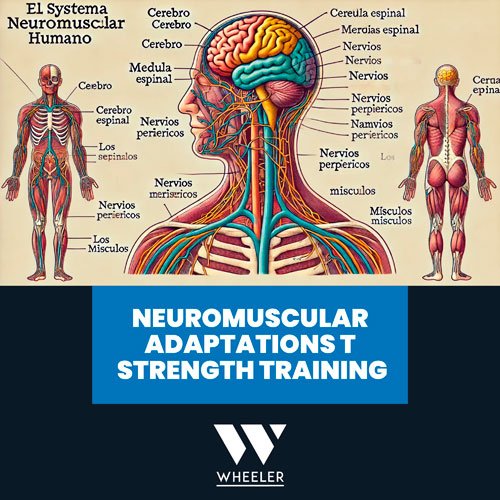Strength training is one of the most effective ways to improve physical performance, and its effects are not limited to muscle mass increase. One of the most interesting aspects of strength training is how the neuromuscular system adapts to these stimuli, enhancing the ability to generate force more efficiently. In this article, we will explore the neuromuscular adaptations to strength training and how they impact explosive strength development, eccentric movement, and muscle activation.
What is Rate of Force Development (RFD)?
Rate of Force Development (RFD) is a key measure that helps us understand how muscles generate force in a short period of time. In simple terms, RFD refers to how much force the body can generate within a very brief time interval, such as in a jump or explosive movements. This rate of force application is measured by taking the difference in the force applied and dividing it by the time it took to apply that force. The greater this ratio, the more force the body can generate in a short time, which is essential in activities like jumping, flywheel squats, or sprinting.
For example, vertical jumping is closely related to RFD, as the speed with which force is applied determines how high the body’s center of gravity can be lifted. By measuring the height of a jump, one can indirectly infer the ability to generate force quickly.
Factors That Determine Rate of Force Development
Several factors determine RFD, with some of the most important being:
- Maximum voluntary muscle contraction: The greater the capacity of the nervous system to quickly activate muscle fibers, the higher the RFD.
- Tendon stiffness: A stiffer tendon can store and transfer energy more efficiently, contributing to higher RFD.
- Intrinsic properties of muscle fibers: Type 2 (fast-twitch) muscle fibers are responsible for generating more explosive force, so a muscle with a higher proportion of these fibers will have a higher RFD.
- Neural activation: Efficient activation of motoneurons is crucial for maximizing RFD. In the first 50 milliseconds of an explosive movement, neural activation is critical.
Furthermore, depending on the duration of the time interval in which RFD is measured, different factors may become more significant. For instance, in the first 50 milliseconds, neural activation is paramount, whereas in longer intervals (200 milliseconds), muscle properties like maximum contraction become more relevant.
Neuromuscular Adaptations to Strength Training
One of the primary adaptations to strength training is the change in the ability to activate muscle fibers. These adaptations can be broadly divided into two main types:
Neural adaptations: These adaptations occur mainly in the early stages of training, particularly within the first 4 to 6 weeks. During this time, strength gains are primarily due to improvements in neural activation, with little to no structural changes in the muscles. Neural improvements include:
- A greater ability to recruit motor units.
- An increased firing rate of motoneurons, which allows for greater force generation in a shorter period of time. This is particularly noticeable in trained individuals, who can activate their muscles more efficiently even after a fatigue protocol.
Structural adaptations: After the fourth week of training, structural adaptations become more evident. These include:
- Muscle hypertrophy.
- An increase in the density of muscle fibers, contributing to maximum strength.
- Enhanced isometric strength and concentric loading, both of which play key roles in explosive force generation.
However, the majority of strength gains in the initial stages of training are due to neural adaptations, such as greater motor unit recruitment and improved intramuscular coordination.
Strength Training in Children and Neuromuscular Adaptation
In children, neuromuscular adaptations to strength training are particularly interesting. Although prepubescent children have low levels of androgenic hormones (like testosterone), which limits structural adaptations, they can experience significant strength improvements due to neuromuscular adaptations. This is because their nervous system is still developing, allowing for improvements in motor unit activation, intramuscular coordination, and flywheel exercises.
This highlights the importance of strength training for children, not only to improve their performance but also to enhance motor coordination and the efficient activation of their muscles. Moreover, even if a child does not significantly increase muscle mass, improvements in their ability to generate force quickly can be observed due to these neuromuscular changes.
The Importance of Ballistic Exercises
To improve RFD and explosive strength, ballistic exercises, such as jumps or plyometric exercises, are highly effective. These exercises not only enhance maximum strength but also increase the rate of force development by reducing inhibitory processes in the nervous system. For instance, plyometric exercises, which involve fast and explosive movements, are excellent for improving RFD in the short term. Flywheel training machines, like the kBox, can further amplify these results by introducing variable resistance throughout the movement.
Studies show that individuals trained with ballistic exercises experience a significant increase in RFD, especially in the initial phase of the force-time curve. This is because this type of training increases the firing rate of motor units, contributing to a greater ability to generate force quickly.
Inhibition of Inhibition: A Key Concept in Explosive Training
An interesting concept in the physiology of explosive training is “inhibition of inhibition.” This refers to the reduction of inhibitory mechanisms in the central nervous system, which typically activate antagonistic muscles to prevent injury during rapid movements. With strength training, particularly with ballistic exercises and tools like flywheel training equipment, the activation of these inhibitory cells can be reduced, allowing for faster movements and greater force production.
Cross-Education: A Phenomenon in Neuromuscular Adaptation
An intriguing phenomenon related to neuromuscular adaptations is cross-education. This phenomenon means that when one limb is trained, the contralateral limb also experiences strength improvements due to neuromuscular adaptations. This principle has practical implications, such as in the case of rehabilitation from an injury to one limb, where training the other limb can help prevent the loss of strength in the injured limb.
Conclusion
Strength training not only improves muscle mass but also triggers a series of neuromuscular adaptations crucial for increasing explosive strength and physical performance. These adaptations include improvements in neural activation, motor unit recruitment, and the reduction of inhibitory mechanisms. Moreover, ballistic and plyometric exercises are essential for enhancing RFD, while tools like flywheel exercise machines and the kBox offer advanced training options for optimizing performance.
As strength trainers and physiotherapists, understanding these adaptations is essential for designing effective training programs that optimize performance and minimize the risk of injury. Whether you’re using eccentric machines, practicing squat variations, or leveraging flywheel resistance training, these strategies can transform training outcomes and redefine strength development.
Author


